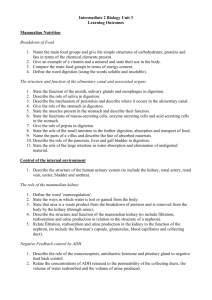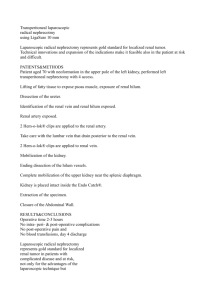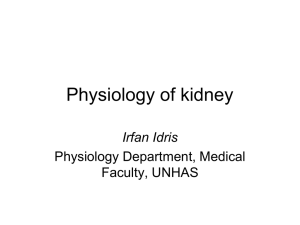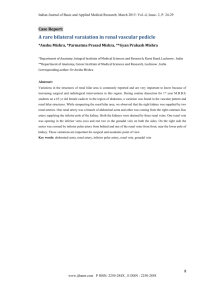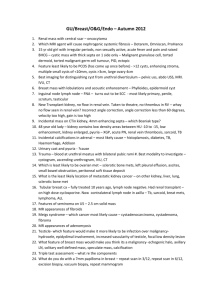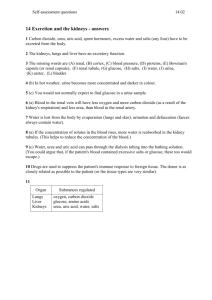114KB
advertisement
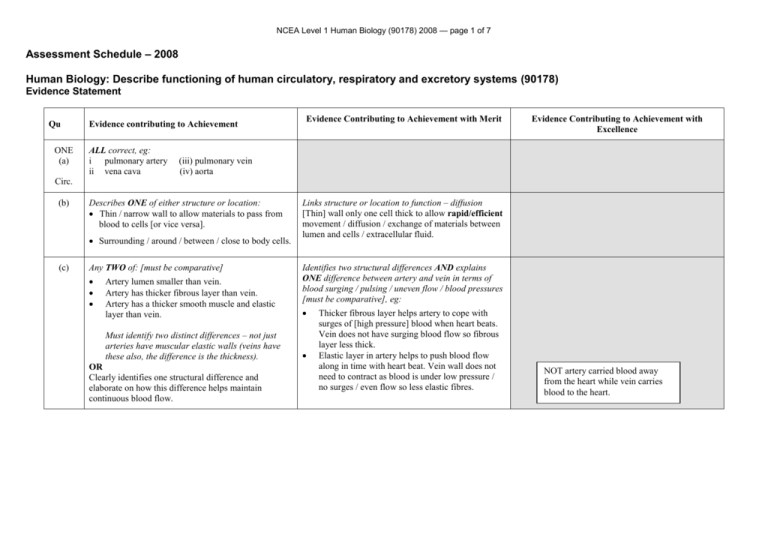
NCEA Level 1 Human Biology (90178) 2008 — page 1 of 7 Assessment Schedule – 2008 Human Biology: Describe functioning of human circulatory, respiratory and excretory systems (90178) Evidence Statement Qu ONE (a) Evidence contributing to Achievement ALL correct, eg: i pulmonary artery ii vena cava Evidence Contributing to Achievement with Merit Evidence Contributing to Achievement with Excellence (iii) pulmonary vein (iv) aorta Circ. (b) Describes ONE of either structure or location: Thin / narrow wall to allow materials to pass from blood to cells [or vice versa]. Surrounding / around / between / close to body cells. (c) Any TWO of: [must be comparative] Artery lumen smaller than vein. Artery has thicker fibrous layer than vein. Artery has a thicker smooth muscle and elastic layer than vein. Must identify two distinct differences – not just arteries have muscular elastic walls (veins have these also, the difference is the thickness). OR Clearly identifies one structural difference and elaborate on how this difference helps maintain continuous blood flow. Links structure or location to function – diffusion [Thin] wall only one cell thick to allow rapid/efficient movement / diffusion / exchange of materials between lumen and cells / extracellular fluid. Identifies two structural differences AND explains ONE difference between artery and vein in terms of blood surging / pulsing / uneven flow / blood pressures [must be comparative], eg: Thicker fibrous layer helps artery to cope with surges of [high pressure] blood when heart beats. Vein does not have surging blood flow so fibrous layer less thick. Elastic layer in artery helps to push blood flow along in time with heart beat. Vein wall does not need to contract as blood is under low pressure / no surges / even flow so less elastic fibres. NOT artery carried blood away from the heart while vein carries blood to the heart. NCEA Level 1 Human Biology (90178) 2008 — page 2 of 7 (d) (e) ONE factor described, eg: Achievement, plus linked to how the factor causes hypertension, eg: [Regular] smoking constricts blood vessels. Narrowing of lumen raises BP as heart has to work / pump harder to get blood through the vessels. Excess [animal] fat / cholesterol in diet sticks to inner wall of arteries / forms plaque. As above. Excess sugar in diet can remain in plasma / blood / thickens blood. Thicker blood means sluggish flow raising BP as heart has to work / pump harder to get the blood moving / flowing. Excess salt in diet raises volume of blood / plasma. Increased volume of blood raises BP as heart has to work / pump harder to get more liquid through same lumen of vessels. Lack of exercise means sluggish blood flow / weaker heart muscle. Sluggish blood flow raises BP as heart has to work / pump harder to get the blood moving / flowing. Stress which causes the release of a hormone what causes the blood vessels to constrict Narrowing of blood vessels raises BP as the heart has to pump / work harder to push the blood through the vessels. Any THREE of what exercise causes or leads to, eg: strengthens heart muscle lowers resting pulse increases / more efficient blood flow increases / more efficient oxygen supply to muscles / body [and CO2 removal] increased CV fitness more able to fight off disease lowers blood pressure reduces plaque build up. Achievement, and explains ONE benefit of regular exercise in terms of increasing efficiency of the heart OR improved blood flow, eg: Regular exercise strengthens the heart muscle, which makes it more efficient at pumping blood as more blood pumped with each contraction / beat. Less plaque build up means that arteries maintain lumen so flow of blood is not reduced. BP low, so heart does not have to work so hard to achieve flow. Comprehensive explanations linking stronger heart muscle to … efficient pumping / lower pulse / reduced BP / reduced plaque build up / efficient flow of blood / and therefore effective transport of materials [named egs] to and from cells / organs, eg: Regular exercise strengthens the heart muscle, which makes it more efficient at pumping blood as more blood pumped with each contraction / beat. Fewer contractions are needed per minute [lower pulse]. Lower pulse means heart gets more rest between beats. AND Less plaque build up means that arteries maintain lumen so flow of blood is not reduced. BP low so heart does not have to work so hard to achieve flow. Efficient flow means efficient supply of materials to organs / cells eg O2 / glucose. NCEA Level 1 Human Biology (90178) 2008 — page 3 of 7 TWO (a) Resp. Any TWO of: Trachea carries air (in or out of mouth / nose / buccal cavity) to / from lungs / bronchi. Cartilage [bands] keep the trachea open / prevent closing / collapse. Diaphragm [muscle / sheet of muscle] that contracts to help inhalation / relaxes to help exhalation. (contracts and relaxes to assist breathing). (b) Any THREE of: [tiny] thin walled / one cell thick wall thin moist layer lining the alveolus alveolus surrounded by capillaries large surface area permeable wall of the alveolus (not “leaky”). (c) Provides detail describing any ONE of dissolving of oxygen / diffusion / concentration gradient, eg.: Explains how concentration gradient is maintained, eg: Oxygen dissolves in thin moist layer of alveolus. Defines diffusion of oxygen – movement of oxygen from high concentration to low concentration. Blood with diffused oxygen is rapidly carried away from site of gas exchange / alveoli to maintain a high concentration gradient at all times. So oxygen continually moves from alveoli to blood. Oxygen diffuses across alveolus and capillary wall. Rapid removal of oxygen from site. (d) Describes ONE feature of asthma narrowing of air tubes [named] reduced air flow into and out of lungs breathlessness / wheezing Achievement linked to reduced ventilation / inhaling – exhaling affecting the amount of oxygen entering body / carbon dioxide leaving. NCEA Level 1 Human Biology (90178) 2008 — page 4 of 7 (e) Any TWO of how the air is different: Dust in inhaled air is removed by cilia and/or mucus. Moisture / water vapour from (surface of) alveoli leaves the body in exhaled air. Inhaled air is warmed as it travels to the lungs / through respiratory system. THREE (a) Achievement plus explains ONE reason (how and why) there is a difference: Particles / dust trapped in sticky mucus. Beating cilia sweep it up to throat for swallowing removing dust so that the exhaled air is clean to maintain efficiency or prevent infection / sickness / illness. Water constantly diffuses from capillaries to alveoli to keep them moist for gas exchange; excess water becomes part of exhaled air. Inhaled air is passing deep into the body, which is at 37°C. Body heat transfers to air and warms it. Eg: at least FIVE correct labels for a reasonable diagram (resembles internal structure of kidney, vessels enter leave in the correct region). Excretn Renal blood vessels may be reverse and arrows not necessary. (b) THREE correct, eg: Urethra carries urine from bladder to outside (body) [NOT urea]. Renal artery supplies blood to kidney / brings urea to kidney / brings blood to be filtered. Ureter takes urine from kidney to bladder [NOT urea]. Bladder stores / holds urine. (c) Describes ONE of, eg: Large capillary network increases filtration / more Explains ONE of, eg: Larger capillary network provides a larger surface In-depth explanations for TWO differences including linking of ideas. NCEA Level 1 Human Biology (90178) 2008 — page 5 of 7 capillaries more filtration. Arteriole entering glomerulus is larger than venule leaving so blood pressure is increased. Filtration in the glomerulus removes the smaller particles (eg, water, urea, salt and glucose). (d) Proteins too big / large to pass through capillary / glomerulus / membranes into Bowman’s capsule. Need to make the link to the membrane. (e) Describes changes to any FOUR substances, eg: area so filtration is faster. Smaller venule helps to increase blood pressure in glomerulus network because blood flow is slowed down. As the smaller particles forced out due to high pressure in the glomerulus. Explains why, eg: Normally the membranes prevent the passage of the large proteins. When membranes are damaged (eg high blood pressure, damage to the nephrons) then proteins can pass through into the filtrate. As Achievement linked to explains how blood composition changes for THREE substances, eg: Blood in renal vein has Blood in renal vein has: less urea same or less salts less water less oxygen more carbon dioxide same or less glucose. Less urea – kidney filtered out urea in the nephrons because urea is a toxic waste. Salt concentration may stay the same if the person has not eaten salty food OR the salt concentration will decrease because excess salts are removed / filtered by the kidneys / nephrons to maintain a constant blood composition. [or vice versa for renal artery]. Less water as water needed to carry dissolved substances like salts, urea in urine OR Excess water not needed by body excreted. Less oxygen because kidney cells carry out respiration using oxygen / need oxygen for energy release. More carbon dioxide because kidney cells respire – carbon dioxide is a waste product of respiration. Less glucose because it was used by the kidney cells in respiration to give the cells energy to carry out their processes / functions. An integrated answer that links how blood composition changed for TWO substances (Note: CO2, O2 and glucose are considered as “one” as the reason is the same –respiration) , eg: Urea made by the liver is filtered out of the blood at the kidneys and passes through the (kidney) tubules to the bladder dissolved in water as urine. Hence renal vein blood carries less urea than renal artery. Excess urea must be removed from the body otherwise it will cause kidney damage or heart damage. Salt levels in the blood must be maintained to prevent high blood pressure. If a person has eaten a salty meal there will be less salt in renal vein blood because more salt is excreted in urine. But if a person eats little salt then the salt levels in the renal vein and renal artery will be similar. Water carries many dissolved substances. Much water is reabsorbed from the kidney tubule back into blood to maintain correct blood composition. But some water is used to dissolve substances like urea (explained above) hence there is less water in renal vein blood than in renal artery blood. Renal vein blood has more carbon dioxide, less glucose and less oxygen than renal artery blood because the NCEA Level 1 Human Biology (90178) 2008 — page 6 of 7 kidney cells / nephrons carry out (aerobic) respiration to provide the cells with energy so the cells can carry out processes of filtration or absorption. NCEA Level 1 Human Biology (90178) 2008 — page 7 of 7 Judgement Statement Achievement Achievement with Merit Achievement with Excellence Total of SEVEN opportunities answered at Achievement level with a minimum of TWO achieved from each organ system. Total of at least NINE opportunities answered with at least TWO at Merit level from one organ system. Total of at least NINE opportunities answered with at least ONE at Excellence level and ONE at Merit level from one organ system. 7A 7 A + 2 M (from one organ system). 1 E + 1 M (from one organ system), plus 7 x A

